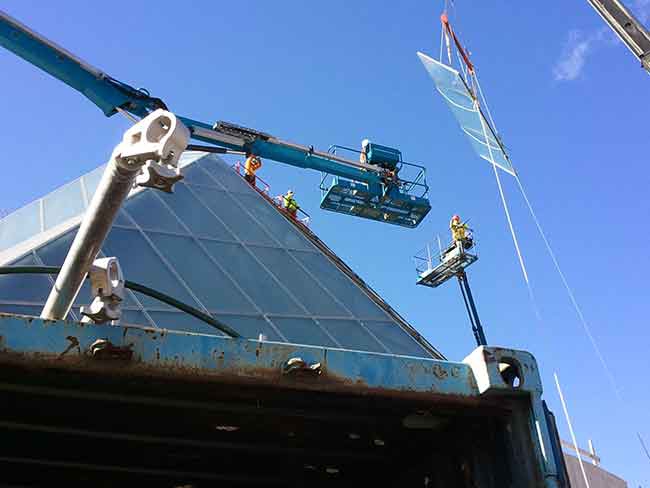
Features
Business intelligence
Contracting
The safety factor
A new study looks at the safety records of companies with unionized workforces. Claims are higher, but lost time lower. Does that make them safer places to work?
February 9, 2016 By Retain Canada
 Commercial glazing is a dangerous job. Worker safety is a constant focus of Canada’s construction unions. New studies throw light on how unions impact safety performance on Ontario construction sites. The results are mixed, and counterintuitive. A union on the jobsite seems to mean more claims, but less lost time.
Commercial glazing is a dangerous job. Worker safety is a constant focus of Canada’s construction unions. New studies throw light on how unions impact safety performance on Ontario construction sites. The results are mixed, and counterintuitive. A union on the jobsite seems to mean more claims, but less lost time. Workers at unionized construction workplaces in Ontario are more likely than their non-unionized counterparts to file job-related injury claims, but less likely to file claims that result in time off work.
That’s one of the findings of a new, groundbreaking study that set out to probe whether unionized construction companies experience fewer workplace injuries than non-unionized ones. The study by the Institute for Work & Health (IWH) was funded by the Ontario Construction Secretariat (OCS), a tripartite organization of government, employer and trade union representatives that promotes the value of organized industrial, commercial and institutional construction in Ontario. The study was recently published online by the Journal of Occupational and Environmental Medicine.
Using claims data from the Workplace Safety and Insurance Board (Ontario’s workers’ compensation board), the study found unionized companies in Ontario’s industrial, commercial and institutional sector, compared to their non-unionized counterparts and when taking firm size into account, have:
- 13 per cent higher rates of total injury claims (both allowed and not allowed);
- 28 per cent higher rates of allowed no-lost-time injury claims (i.e. claims that require health care but don’t result in time off work beyond the day of injury);
- 14 per cent lower rates of allowed lost-time claims (i.e. claims that involve missed days of work); and
- eight per cent lower rates of musculoskeletal injuries.
When not adjusted for firm size, the results show unionized firms have 13 per cent higher rates of total injury claims, 35 per cent higher rates of no-lost-time claims, 23 per cent lower rates of lost-time claims, and 17 per cent lower rates of musculoskeletal injuries.
However, adjusting for firm size takes into account that larger firms, both unionized and non-unionized, may have greater resources to devote to injury prevention and post-injury work accommodation.
“These findings suggest to us that unionized workers may be more likely to report injuries, including injuries that don’t require time off work, at workplaces where managers and supervisors are committed to safety,” said Dr. Ben Amick, IWH senior scientist and co-lead investigator on the study.
While unionized workers may be more inclined to make work-related injury claims, these findings suggest that their claims are less likely to be of a serious nature, he adds.
“The lower rates of lost-time claims might also suggest that unionized workplaces are safer,” added Dr. Sheilah Hogg-Johnson, IWH associate scientific director and project co-lead. “It could be they do a better job educating workers, in part through apprenticeship training. They may have more effective health and safety programs and practices. They may give workers more voice to influence the health and safety of their work environments, and to report not only injuries, but also near-misses.”
Other factors also need to be ruled out before one can say with confidence that unionized construction firms are safer, Amick noted. One potentially confounding factor may be that unionized workers are older and more experienced at working safely. Another may be that unionized workplaces are better at offering employees modified work the day after an injury.
“Our research doesn’t allow us to say what explains the difference in claim rates between the unionized and non-unionized firms,” Hogg-Johnson said. To help dig deeper, the IWH team is currently studying the organizational practices and policies of a sample of construction firms to examine what is behind the apparent union-safety effect.
Studies comparing unionized and non-unionized workplaces are very difficult to do because of a lack of data. They require datasets that are large enough to ensure that the sample is representative of the labour market. Thanks to the involvement of OCS, the IWH research team had access to a very comprehensive, province-wide database of unionized firms in the province’s industrial, commercial and institutional construction sector.
For this study, the research team analyzed seven years of injury claims data (2006 to 2012 inclusive) for 5,800 unionized firms employing 720,000 full-time-equivalent (FTE) workers and 39,000 non-unionized firms employing 810,000 FTEs.
“Creating safe and healthy workplaces is a core deliverable of unionized construction firms in Ontario,” said Sean Strickland, chief executive officer of the Ontario Construction Secretariat. “We’ve recognized the need to move beyond simply saying unionized construction workplaces are safer, to actually proving that they’re safer. This groundbreaking study is only the first step in understanding the conditions that lead to better health and safety outcomes for Ontario’s construction workers.”
Retain is a multimedia website delivering the pension and benefit information small and medium sized businesses need to recruit and retain top talent. retaincanada.ca
Print this page
Leave a Reply